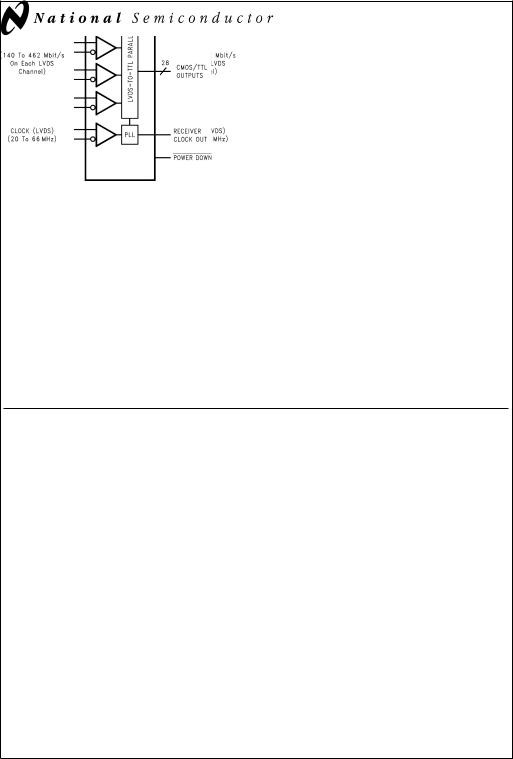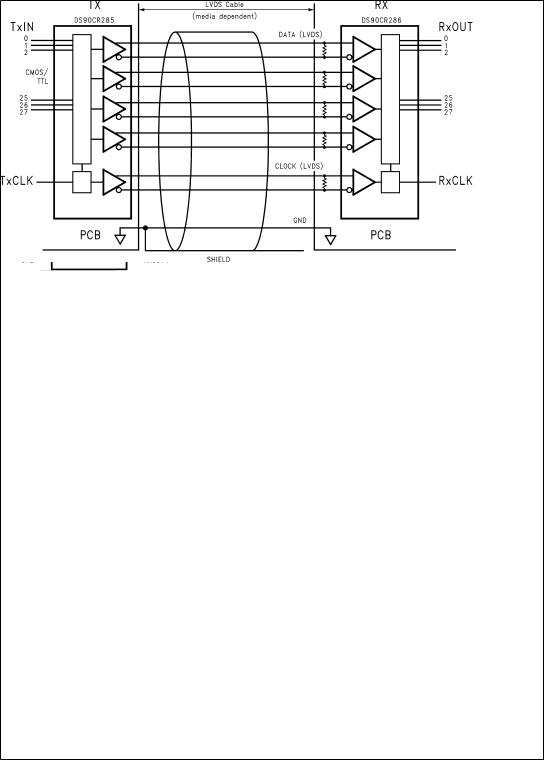NSC DS90CR285MTDX, DS90CR285MTD, CLINK3V28BT-66 Datasheet

March 1999
DS90CR285/DS90CR286
+3.3V Rising Edge Data Strobe LVDS 28-Bit Channel
Link-66 MHz
General Description
The DS90CR285 transmitter converts 28 bits of CMOS/TTL data into four LVDS (Low Voltage Differential Signaling) data streams. A phase-locked transmit clock is transmitted in parallel with the data streams over a fifth LVDS link. Every cycle of the transmit clock 28 bits of input data are sampled and transmitted. The DS90CR286 receiver converts the LVDS data streams back into 28 bits of CMOS/TTL data. At a transmit clock frequency of 66 MHz, 28 bits of TTL data are transmitted at a rate of 462 Mbps per LVDS data channel. Using a 66 MHz clock, the data throughput is 1.848 Gbit/s (231 Mbytes/s).
The multiplexing of the data lines provides a substantial cable reduction. Long distance parallel single-ended buses typically require a ground wire per active signal (and have very limited noise rejection capability). Thus, for a 28-bit wide data and one clock, up to 58 conductors are required. With the Channel Link chipset as few as 11 conductors (4 data pairs, 1 clock pair and a minimum of one ground) are needed. This provides a 80% reduction in required cable width, which provides a system cost savings, reduces connector physical size and cost, and reduces shielding requirements due to the cables' smaller form factor.
The 28 CMOS/TTL inputs can support a variety of signal combinations. For example, seven 4-bit nibbles or three 9-bit (byte + parity) and 1 control.
Features
nSingle +3.3V supply
nChipset (Tx + Rx) power consumption <250 mW (typ)
nPower-down mode (<0.5 mW total)
nUp to 231 Megabytes/sec bandwidth
nUp to 1.848 Gbps data throughput
nNarrow bus reduces cable size
n290 mV swing LVDS devices for low EMI
n+1V common mode range (around +1.2V)
nPLL requires no external components
nLow profile 56-lead TSSOP package
nRising edge data strobe
nCompatible with TIA/EIA-644 LVDS standard
nESD Rating > 7 kV
nOperating Temperature: −40ÊC to +85ÊC
Block Diagrams
DS90CR285 |
DS90CR286 |
DS012910-1 |
DS012910-27 |
Order Number DS90CR285MTD |
Order Number DS90CR286MTD |
See NS Package Number MTD56 |
See NS Package Number MTD56 |
TRI-STATE® is a registered trademark of National Semiconductor Corporation.
MHz 66-Link Channel Bit-28 LVDS Strobe Data Edge Rising 3V.+3 DS90CR285/DS90CR286
© 1999 National Semiconductor Corporation |
DS012910 |
www.national.com |

Pin Diagrams
DS90CR285 |
DS90CR286 |
DS012910-21 |
DS012910-22 |
Typical Application
DS012910-23
www.national.com |
2 |

Absolute Maximum Ratings (Note 1)
If Military/Aerospace specified devices are required, please contact the National Semiconductor Sales Office/ Distributors for availability and specifications.
Supply Voltage (VCC) |
−0.3V to +4V |
CMOS/TTL Input Voltage |
−0.3V to (V CC + 0.3V) |
CMOS/TTL Output Voltage |
−0.3V to (V CC + 0.3V) |
LVDS Receiver Input |
−0.3V to (V CC + 0.3V) |
Voltage |
|
LVDS Driver Output Voltage |
−0.3V to (V CC + 0.3V) |
LVDS Output Short Circuit |
|
Duration |
Continuous |
Junction Temperature |
+150ÊC |
Storage Temperature |
−65ÊC to +150ÊC |
Lead Temperature |
|
(Soldering, 4 sec.) |
+260ÊC |
Maximum Package Power Dissipation @ +25ÊC
MTD56 (TSSOP) Package:
DS90CR285 |
1.63 W |
DS90CR286 |
1.61 W |
Package Derating: |
|
DS90CR285 |
12.5 mW/ÊC above +25ÊC |
DS90CR286 |
12.4 mW/ÊC above +25ÊC |
ESD Rating |
|
(HBM, 1.5 kΩ, 100 pF) |
> 7 kV |
Recommended Operating
Conditions
|
Min |
Nom |
Max |
Units |
Supply Voltage (VCC) |
3.0 |
3.3 |
3.6 |
V |
Operating Free Air |
|
|
|
|
Temperature (TA) |
−40 |
+25 |
+85 |
ÊC |
Receiver Input Range |
|
0 |
2.4 |
V |
Supply Noise Voltage (VCC) |
|
|
|
100 mVPP |
Electrical Characteristics
Over recommended operating supply and temperature ranges unless otherwise specified
Symbol |
Parameter |
|
|
Conditions |
Min |
Typ |
Max |
Units |
|
|
|
|
|
|
|
|
|
CMOS/TTL DC SPECIFICATIONS |
|
|
|
|
|
|
|
|
VIH |
High Level Input Voltage |
|
|
|
2.0 |
|
VCC |
V |
VIL |
Low Level Input Voltage |
|
|
|
GND |
|
0.8 |
V |
VOH |
High Level Output Voltage |
|
IOH = −0.4 mA |
2.7 |
3.3 |
|
V |
|
VOL |
Low Level Output Voltage |
|
IOL = 2 mA |
|
0.06 |
0.3 |
V |
|
VCL |
Input Clamp Voltage |
|
ICL = −18 mA |
|
−0.79 |
−1.5 |
V |
|
IIN |
Input Current |
|
VIN = VCC, GND, 2.5V or 0.4V |
|
±5.1 |
±10 |
µA |
|
IOS |
Output Short Circuit Current |
|
VOUT = 0V |
|
−60 |
−120 |
mA |
|
LVDS DRIVER DC SPECIFICATIONS |
|
|
|
|
|
|
|
|
|
|
|
|
|
|
|
|
|
VOD |
Differential Output Voltage |
|
RL = 100Ω |
250 |
290 |
450 |
mV |
|
VOD |
Change in VOD between |
|
|
|
|
|
35 |
mV |
|
Complimentary Output States |
|
|
|
|
|
|
|
|
|
|
|
|
|
|
|
|
VOS |
Offset Voltage (Note 4) |
|
|
|
1.125 |
1.25 |
1.375 |
V |
VOS |
Change in VOS between |
|
|
|
|
|
35 |
mV |
|
Complimentary Output States |
|
|
|
|
|
|
|
|
|
|
|
|
|
|
|
|
IOS |
Output Short Circuit Current |
|
VOUT = 0V, RL = 100Ω |
|
−3.5 |
−5 |
mA |
|
IOZ |
Output TRI-STATE® Current |
|
|
|
±1 |
±10 |
µA |
|
|
PWR DWN |
= 0V, |
|
|||||
|
|
VOUT = 0V or VCC |
|
|
|
|
||
LVDS RECEIVER DC SPECIFICATIONS |
|
|
|
|
|
|
|
|
|
|
|
|
|
|
|
|
|
VTH |
Differential Input High Threshold |
|
VCM = +1.2V |
|
|
+100 |
mV |
|
VTL |
Differential Input Low Threshold |
|
|
|
−100 |
|
|
mV |
IIN |
Input Current |
|
VIN = +2.4V, VCC = 3.6V |
|
|
±10 |
µA |
|
|
|
VIN = 0V, VCC = 3.6V |
|
|
±10 |
µA |
||
3 |
www.national.com |

Electrical Characteristics (Continued)
Over recommended operating supply and temperature ranges unless otherwise specified
Symbol |
Parameter |
|
|
Conditions |
Min |
Typ |
Max |
Units |
|
TRANSMITTER SUPPLY CURRENT |
|
|
|
|
|
|
|
|
|
|
|
|
|
|
|
|
|
|
|
ICCTW |
Transmitter Supply Current |
|
RL = 100Ω, |
f = 32.5 MHz |
|
31 |
45 |
mA |
|
|
Worst Case (with Loads) |
|
CL = 5 pF, |
|
|
|
|
|
|
|
|
|
Worst Case |
|
|
|
|
|
|
|
|
f = 37.5 MHz |
|
32 |
50 |
mA |
|||
|
|
|
Pattern |
|
|||||
|
|
|
|
|
|
|
|
||
|
|
|
(Figures 1, 2), |
|
|
|
|
|
|
|
|
|
TA = −10ÊC to |
f = 66 MHz |
|
37 |
55 |
mA |
|
|
|
|
+70ÊC |
|
|
|
|
|
|
|
|
|
|
|
|
|
|
|
|
|
|
|
RL = 100Ω, |
f = 40 MHz |
|
38 |
51 |
mA |
|
|
|
|
CL = 5 pF, |
|
|
|
|
|
|
|
|
|
Worst Case |
|
|
|
|
|
|
|
|
|
Pattern |
|
|
|
|
|
|
|
|
f = 66 MHz |
|
42 |
55 |
mA |
|||
|
|
|
(Figures 1, 2), |
|
|||||
|
|
|
|
|
|
|
|
||
|
|
|
TA = −40ÊC to |
|
|
|
|
|
|
|
|
|
+85ÊC |
|
|
|
|
|
|
ICCTZ |
Transmitter Supply Current |
|
|
|
|
10 |
55 |
µA |
|
|
PWR DWN |
= Low |
|
|
|||||
|
Power Down |
|
Driver Outputs in TRI-STATE |
|
|
|
|
||
|
|
|
under Powerdown Mode |
|
|
|
|
||
|
|
|
|
|
|
|
|
|
|
RECEIVER SUPPLY CURRENT |
|
|
|
|
|
|
|
|
|
|
|
|
|
|
|
|
|
|
|
ICCRW |
Receiver Supply Current Worst |
|
CL = 8 pF, |
f = 32.5 MHz |
|
49 |
65 |
mA |
|
|
Case |
|
Worst Case |
|
|
|
|
|
|
|
|
|
Pattern |
f = 37.5 MHz |
|
53 |
70 |
mA |
|
|
|
|
(Figures 1, 3), |
|
|
|
|
|
|
|
|
|
TA = −10ÊC to |
f = 66 MHz |
|
78 |
105 |
mA |
|
|
|
|
+70ÊC |
|
|
|
|
|
|
|
|
|
|
|
|
|
|
|
|
|
|
|
CL = 8 pF, |
f = 40 MHz |
|
55 |
82 |
mA |
|
|
|
|
Worst Case |
|
|
|
|
|
|
|
|
|
Pattern |
|
|
|
|
|
|
|
|
|
(Figures 1, 3), |
f = 66 MHz |
|
78 |
105 |
mA |
|
|
|
|
TA = −40ÊC to |
|
|
|
|
|
|
|
|
|
+85ÊC |
|
|
|
|
|
|
|
|
|
|
|
|
|
|
|
|
ICCRZ |
Receiver Supply Current Power |
|
|
|
|
10 |
55 |
µA |
|
|
PWR DWN |
= Low |
|
|
|||||
|
Down |
|
Receiver Outputs Stay Low during |
|
|
|
|
||
|
|
|
Powerdown Mode |
|
|
|
|
|
|
|
|
|
|
|
|
|
|
|
|
Note 1: ªAbsolute Maximum Ratingsº are those values beyond which the safety of the device cannot be guaranteed. They are not meant to imply that the device should be operated at these limits. The tables of ªElectrical Characteristicsº specify conditions for device operation.
Note 2: Typical values are given for VCC = 3.3V and TA = +25ÊC.
Note 3: Current into device pins is defined as positive. Current out of device pins is defined as negative. Voltages are referenced to ground unless otherwise specified (except VOD and VOD).
Note 4: VOS previously referred as VCM.
Transmitter Switching Characteristics
Over recommended operating supply and −40ÊC to +85ÊC ranges unless otherwise specified
Symbol |
Parameter |
|
Min |
Typ |
Max |
Units |
|
|
|
|
|
|
|
LLHT |
LVDS Low-to-High Transition Time (Figure 2) |
|
0.5 |
1.5 |
ns |
|
|
|
|
|
|
|
|
LHLT |
LVDS High-to-Low Transition Time (Figure 2) |
|
0.5 |
1.5 |
ns |
|
|
|
|
|
|
|
|
TCIT |
TxCLK IN Transition Time (Figure 4) |
|
|
|
5 |
ns |
|
|
|
|
|
|
|
TCCS |
TxOUT Channel-to-Channel Skew (Figure 5) |
|
250 |
|
ps |
|
|
|
|
|
|
|
|
TPPos0 |
Transmitter Output Pulse Position for |
f = 40 MHz |
−0.4 |
0 |
0.4 |
ns |
|
Bit0 (Note 7) (Figure 16) |
|
|
|
|
|
|
|
|
|
|
|
|
TPPos1 |
Transmitter Output Pulse Position for |
|
3.1 |
3.3 |
4.0 |
ns |
|
Bit1 |
|
|
|
|
|
|
|
|
|
|
|
|
TPPos2 |
Transmitter Output Pulse Position for |
|
6.5 |
6.8 |
7.6 |
ns |
|
Bit2 |
|
|
|
|
|
www.national.com |
4 |

Transmitter Switching Characteristics (Continued)
Over recommended operating supply and −40ÊC to +85ÊC ranges unless otherwise specified
Symbol |
Parameter |
|
Min |
Typ |
Max |
Units |
TPPos3 |
Transmitter Output Pulse Position for |
|
10.2 |
10.4 |
11.0 |
ns |
|
Bit3 |
|
|
|
|
|
|
|
|
|
|
|
|
TPPos4 |
Transmitter Output Pulse Position for |
|
13.7 |
13.9 |
14.6 |
ns |
|
Bit4 |
|
|
|
|
|
|
|
|
|
|
|
|
TPPos5 |
Transmitter Output Pulse Position for |
|
17.3 |
17.6 |
18.2 |
ns |
|
Bit5 |
|
|
|
|
|
|
|
|
|
|
|
|
TPPos6 |
Transmitter Output Pulse Position for |
|
21.0 |
21.2 |
21.8 |
ns |
|
Bit6 |
|
|
|
|
|
TPPos0 |
Transmitter Output Pulse Position for |
f = 66 MHz |
−0.4 |
0 |
0.3 |
ns |
|
Bit0 (Note 6) (Figure 16) |
|
|
|
|
|
|
|
|
|
|
|
|
TPPos1 |
Transmitter Output Pulse Position for |
|
1.8 |
2.2 |
2.5 |
ns |
|
Bit1 |
|
|
|
|
|
|
|
|
|
|
|
|
TPPos2 |
Transmitter Output Pulse Position for |
|
4.0 |
4.4 |
4.7 |
ns |
|
Bit2 |
|
|
|
|
|
|
|
|
|
|
|
|
TPPos3 |
Transmitter Output Pulse Position for |
|
6.2 |
6.6 |
6.9 |
ns |
|
Bit3 |
|
|
|
|
|
|
|
|
|
|
|
|
TPPos4 |
Transmitter Output Pulse Position for |
|
8.4 |
8.8 |
9.1 |
ns |
|
Bit4 |
|
|
|
|
|
|
|
|
|
|
|
|
TPPos5 |
Transmitter Output Pulse Position for |
|
10.6 |
11.0 |
11.3 |
ns |
|
Bit5 |
|
|
|
|
|
|
|
|
|
|
|
|
TPPos6 |
Transmitter Output Pulse Position for |
|
12.8 |
13.2 |
13.5 |
ns |
|
Bit6 |
|
|
|
|
|
|
|
|
|
|
|
|
TCIP |
TxCLK IN Period (Figure 6 ) |
|
15 |
T |
50 |
ns |
|
|
|
|
|
|
|
TCIH |
TxCLK IN High Time (Figure 6) |
|
0.35T |
0.5T |
0.65T |
ns |
|
|
|
|
|
|
|
TCIL |
TxCLK IN Low Time (Figure 6) |
|
0.35T |
0.5T |
0.65T |
ns |
|
|
|
|
|
|
|
TSTC |
TxIN Setup to TxCLK IN (Figure 6) |
|
2.5 |
|
|
ns |
|
|
|
|
|
|
|
THTC |
TxIN Hold to TxCLK IN (Figure 6) |
|
0 |
|
|
ns |
|
|
|
|
|
|
|
TCCD |
TxCLK IN to TxCLK OUT Delay @ 25ÊC,VCC=3.3V |
3 |
3.7 |
5.5 |
ns |
|
|
(Figure 8) |
|
|
|
|
|
|
|
|
|
|
|
|
TPLLS |
Transmitter Phase Lock Loop Set (Figure 10) |
|
|
10 |
ms |
|
|
|
|
|
|
|
|
TPDD |
Transmitter Powerdown Delay (Figure 14) |
|
|
|
100 |
ns |
|
|
|
|
|
|
|
Receiver Switching Characteristics
Over recommended operating supply and −40ÊC to +85ÊC ranges unless otherwise specified
Symbol |
Parameter |
|
Min |
Typ |
Max |
Units |
|
|
|
|
|
|
|
CLHT |
CMOS/TTL Low-to-High Transition Time (Figure 3) |
|
|
2.2 |
5.0 |
ns |
|
|
|
|
|
|
|
CHLT |
CMOS/TTL High-to-Low Transition Time (Figure 3) |
|
|
2.2 |
5.0 |
ns |
|
|
|
|
|
|
|
RSPos0 |
Receiver Input Strobe Position for Bit 0 (Note 7)(Figure 17) |
f = 40 MHz |
1.0 |
1.4 |
2.15 |
ns |
|
|
|
|
|
|
|
RSPos1 |
Receiver Input Strobe Position for Bit 1 |
|
4.5 |
5.0 |
5.8 |
ns |
|
|
|
|
|
|
|
RSPos2 |
Receiver Input Strobe Position for Bit 2 |
|
8.1 |
8.5 |
9.15 |
ns |
|
|
|
|
|
|
|
RSPos3 |
Receiver Input Strobe Position for Bit 3 |
|
11.6 |
11.9 |
12.6 |
ns |
|
|
|
|
|
|
|
RSPos4 |
Receiver Input Strobe Position for Bit 4 |
|
15.1 |
15.6 |
16.3 |
ns |
|
|
|
|
|
|
|
RSPos5 |
Receiver Input Strobe Position for Bit 5 |
|
18.8 |
19.2 |
19.9 |
ns |
|
|
|
|
|
|
|
RSPos6 |
Receiver Input Strobe Position for Bit 6 |
|
22.5 |
22.9 |
23.6 |
ns |
|
|
|
|
|
|
|
5 |
www.national.com |
